Finite Element Analysis and In-Situ Measurement of Out-of-Plane Distortion in Thin Plate TIG Welding
Abstract
1. Introduction
2. In-Situ Measurement of Welding Distortion
2.1. Welding Experiment and Measuring System
2.2. Welding Distortion Measurement by DIC Technique
3. Finite Element Analysis
3.1. Transient Thermal Elastic–Plastic FEM
3.2. Computation Flowchart
4. Results and Discussion
4.1. Comparison of Welding Distortion in Baseline Model
4.2. Effect of Initial Plate Shape on Distortion Mode
4.3. Parametric Study on the Effect of Welding Heat Input
5. Conclusions
- (1)
- The developed 3D thermal–mechanical FEM method can accurately predict the transient distortion in welding by considering the measured geometrical imperfection.
- (2)
- The initial deformation of the plate has a large influence on both the deformation mode and the magnitude. The out-of-plane deformation in the opposite direction may be produced if the initial deformation is reversed.
- (3)
- The distance between the welding torch and weldment tends to decrease if the initial shape of the plate is convex, which may interrupt the welding process if contact between electrode and plate occurs. To maintain the weld quality, adaptive arc length control or additional constraint should be introduced.
- (4)
- The relationship between heat input and maximum deflection is not linear, there is a critical heat input beyond which the out-of-plane distortion starts to grow very quickly. Heat input can be optimized with the aid of numerical simulations to avoid the excessive welding distortion.
Author Contributions
Funding
Acknowledgments
Conflicts of Interest
References
- Terasaki, T.; Maeda, K.; Murakawa, H.; Nomoto, T. Critical Conditions of Plate Buckling Generated by Welding. J. Jpn. Soc. Mech. Eng. 1998, 64, 2239–2244. [Google Scholar] [CrossRef]
- Tsai, C.L.; Han, M.S.; Jung, G.H. Investigating the bifurcation phenomenon in plate welding. Weld. J. 2006, 85, 151–162. [Google Scholar]
- Pircher, M.; O’Shea, M.D.; Bridge, R.Q. The influence of the fabrication process on the buckling of thin-walled steel box sections. Thin Wall. Struct. 2002, 40, 109–123. [Google Scholar] [CrossRef]
- Chu, H.; Cho, S. A Study on the Buckling in Fillet Welds of Sheets. J. Weld. Join. 2009, 27, 60–66. [Google Scholar] [CrossRef]
- Shibahara, M.; Ikushima, K.; Itoh, S. Development of in situ measurement system for welding deformation using digital cameras. Sci. Technol. Weld. Join. 2012, 17, 511–517. [Google Scholar] [CrossRef]
- Guo, N.; Yin, X.; Liang, J.; Ma, N. Weld Bead Distortion of Thin-Plate Using Weak Digital Image Correlation Method. J. Mater. Eng. Perform. 2016, 25, 4952–4958. [Google Scholar] [CrossRef]
- Goldak, J.A.; Akhlaghi, M. Computational Welding Mechanics; Springer Science & Business Media: Berlin/Heidelberg, Germany, 2006. [Google Scholar]
- Ueda, Y.; Murakawa, H.; Ma, N. Welding Deformation and Residual Stress Prevention; Elsevier: New York, NY, USA, 2012. [Google Scholar]
- Zhong, X.M.; Murakawa, H.; Ueda, Y. Buckling behavior of plates under Idealized Inherent Strain. Trans. JWRI 1995, 24, 87–91. [Google Scholar]
- Michaleris, P.; Debiccari, A.A. Predictive technique for buckling analysis of thin section panels due to welding. J. Ship. Prod. Des. 1996, 12, 269–275. [Google Scholar]
- Siva Prasad, N.; Sankaranarayanan, T.K. Estimation of residual stresses in weldments using adaptive grids. Comput. Struct. 1996, 80, 1037–1045. [Google Scholar] [CrossRef]
- Chang, P.H.; Teng, T.L. Numerical and experimental investigations on the residual stresses of the butt welded joints. Comp. Mater. Sci. 2004, 29, 511–522. [Google Scholar] [CrossRef]
- Armentani, E.; Pozzi, A.; Sepe, R. Finite-element simulation of temperature fields and residual stresses in butt welded joints and comparison with experimental measurements. In Proceedings of the ASME 2014 12th Biennial Conference on Engineering Systems Design and Analysis, ESDA 2014, Copenhagen, Denmark, 25–27 June 2014. [Google Scholar]
- Tsirkas, S.A.; Papanikos, P.; Kermanidis, T. Numerical simulation of the laser welding process in butt-joint specimens. J. Mater. Process. Technol. 2003, 134, 59–69. [Google Scholar] [CrossRef]
- Nishikawa, H.; Oda, I.; Shibahara, M.; Serizawa, H.; Murakawa, H. Three-dimensional thermal-elastic–plastic FEM analysis for predicting residual stress and deformation under multi-pass welding. In Proceedings of the Fourteenth International Offshore and Polar Engineering Conference, Toulon, France, 23–28 May 2004. [Google Scholar]
- Murakawa, H.; Ma, N.; Huang, H. Iterative substructure method employing concept of inherent strain for large scale welding problem. Weld. World. 2015, 59, 53–63. [Google Scholar] [CrossRef]
- Huang, H.; Ma, N.; Hashimoto, T.; Murakawa, H. Welding deformation and residual stresses in arc welded lap joints by modified iterative analysis. Sci. Technol. Weld. Join. 2015, 20, 571–577. [Google Scholar] [CrossRef]
- Ma, N. An Accelerated Explicit Method and GPU parallel computing for Thermal Stress and Welding Deformation for large structural models. Int. J. Adv. Manuf. Technol. 2016, 87, 2195–2211. [Google Scholar] [CrossRef]
- Ma, N.; Yuan, S. Accelerated Explicit FEM and GPU parallel computing for Thermal Stress and Welding Deformation of automotive parts. Int. J. Appl. Mech. 2016, 8, 1–23. [Google Scholar] [CrossRef]
- Rong, Y.; Zhang, G.; Huang, Y. Study on deformation and residual stress of laser welding 316L T-joint using 3D/shell finite element analysis and experiment verification. Int. J. Adv. Manuf. Technol. 2017, 89, 2077–2085. [Google Scholar] [CrossRef]
- Deng, D.; Murakawa, H. FEM prediction of buckling distortion induced by welding in thin plate panel structures. Comp. Mater. Sci. 2008, 43, 591–607. [Google Scholar] [CrossRef]
- Heinze, C.; Schwenk, C.; Rethmeier, M. Influences of mesh density and transformation behavior on the result quality of numerical calculation of welding induced distortion. Simul. Model. Pract. Theory 2011, 19, 1847–1859. [Google Scholar] [CrossRef]
- Wang, J.; Yin, X.; Murakawa, H. Experimental and computational analysis of residual buckling distortion of bead-on-plate welded joint. J. Mater. Process. Technol. 2013, 213, 1447–1458. [Google Scholar] [CrossRef]
- Yang, Y.P.; Brust, F.W.; Dong, P.; Zhang, J.; Cao, Z. Modeling procedure development of buckling distortion in thin plate welding. ASME-Publ. 2000, 410, 103–108. [Google Scholar]
- Bhatti, A.A.; Barsoum, Z.; Murakawa, H.; Barsoum, I. Influence of thermo-mechanical material properties of different steel grades on welding residual stresses and angular distortion. Mater. Des. 2015, 65, 878–889. [Google Scholar] [CrossRef]
- Huang, H.; Wang, J.; Li, L.; Ma, N. Prediction of laser welding induced deformation in thin sheets by efficient numerical modeling. J. Mater. Process. Technol. 2016, 227, 117–128. [Google Scholar] [CrossRef]
- Yang, Y.P.; Dong, P. Buckling distortions and mitigation techniques for thin-section structures. J. Mater. Eng. Perform. 2012, 21, 153–160. [Google Scholar] [CrossRef]
- Deo, M.V.; Michaleris, P. Mitigation of welding induced buckling distortion using transient thermal tensioning. Sci. Technol. Weld. Join. 2003, 8, 49–54. [Google Scholar] [CrossRef]
- Liu, W.; Ma, J.; Kong, F.; Liu, S.; Kovacevic, R. Numerical modeling and experimental verification of residual stress in autogenous laser welding of high-strength steel. Lasers Manuf. Mater. Process. 2015, 2, 24–42. [Google Scholar] [CrossRef]
- Chu, T.C.; Rasson, W.F.; Sutton, M.A.; Peters, W.H. Applications of digital-image-correlation techniques to experimental mechanics. Exp. Mech. 1985, 25, 232–244. [Google Scholar] [CrossRef]
- Ma, N.; Sato, K.; Takada, K. Analysis of Local Fracture Strain and Damage Limit of Advanced High Strength Steels using Measured Displacement Fields and FEM. CMC-Comput. Mater. Contin. 2015, 46, 195–219. [Google Scholar]
- Perrella, M.; Berardi, V.P.; Cricrì, G. A novel methodology for shear cohesive law identification of bonded reinforcements. Compos. Part B Eng. 2018, 144, 126–133. [Google Scholar] [CrossRef]
- Xiao, Z.Z.; Liang, J.; Yu, D.H. Study on the technologies of rapid three-dimension optical measurement for welding deformation of sheet materials. Adv. Mater. Res. 2010, 97, 4251–4256. [Google Scholar] [CrossRef]
- De Strycker, M.; Lava, P.; Van Paepegem, W. Measuring Welding Distortions with the Digital Image Correlation Technique. Weld. J. 2011, 90, 107–112. [Google Scholar]
- Chen, Z.; Chen, J.; Feng, Z.; Zhang, Y. In situ strain monitoring in gas tungsten arc welding processes. In Proceedings of the IEEE International Conference on Advanced Intelligent Mechatronics (AIM) 2016, Banff, AB, Canada, 12–15 July 2016; pp. 800–804. [Google Scholar]
- Chen, J.; Tatman, J.; Chen, Z.; Feng, Z.; Frederick, G. Proactive In-Situ Welding Stress Control for Laser Repair Welding of Irradiated Austenitic Materials. In Proceedings of the ASME 2017 Pressure Vessels and Piping Conference, Waikoloa, HI, USA, 16–20 July 2017. [Google Scholar]
- Sun, Z.Q.; Yang, W.Y.; Qi, J.J.; Hu, A.M. Deformation enhanced transformation and dynamic recrystallization of ferrite in a low carbon steel during multipass hot deformation. Mater. Sci. Eng. A 2002, 334, 201–206. [Google Scholar] [CrossRef]
- Coret, M.; Calloch, S.; Combescure, A. Experimental study of the phase transformation plasticity of 16MND5 low carbon steel under multiaxial loading. Int. J. Plast. 2002, 18, 1707–1727. [Google Scholar] [CrossRef]
- Nagai, T.; Kasai, R.; Ueno, K.; Mochizuki, M.; Suga, T. Effects of metal types on residual stress in electron-beam welding joints with sheet metals. ISIJ Int. 2015, 55, 241–249. [Google Scholar] [CrossRef]
- Zienkiewicz, O.C.; Taylor, R.L. The Finite Element Method: Solid Mechanics (Vol. 2); Wiley: Hoboken, NJ, USA, 2000. [Google Scholar]
- Owaku, S. JIS Iron and Steel Materials Introduction (New Revised Edition); Taiga Publishing: Ann Arbor, MI, USA, 1978; p. 12. [Google Scholar]
- Huang, H.; Murakawa, H. Development of Dynamic Mesh Refining Method for Large Scale Thermal and Mechanical Analysis in Welding and Line Heating. Trans. JWRI 2013, 42, 63–70. [Google Scholar]
- Huang, H.; Murakawa, H. Dynamic Mesh Refining and Iterative Substructure Method for Fillet Welding Thermo-Mechanical Analysis. CMES-Comp. Model. Eng. 2015, 106, 187–201. [Google Scholar]
- Tashiro, S.; Tsujimura, Y.; Tanaka, M. Numerical model with arc length variation of welding arc with constant voltage power source. Trans. JWRI 2012, 41, 7–10. [Google Scholar]

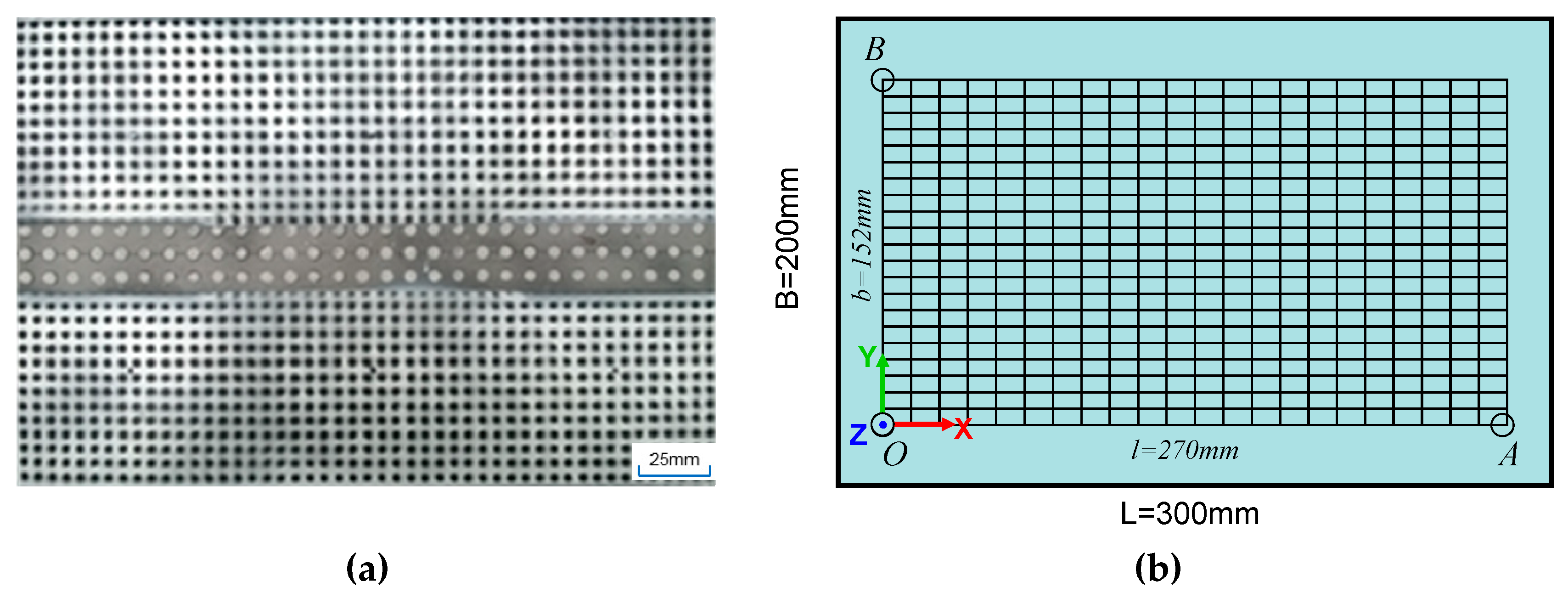
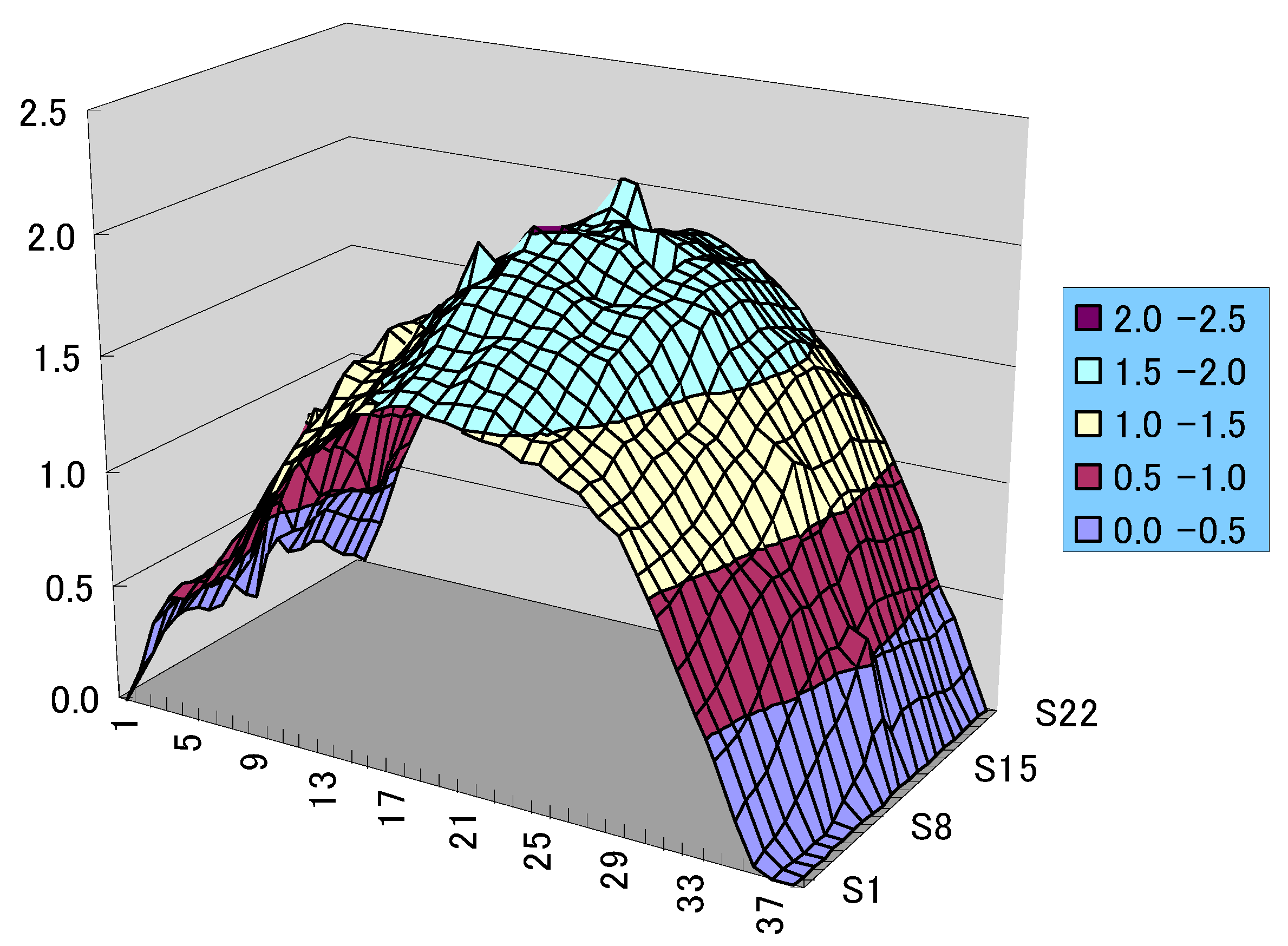
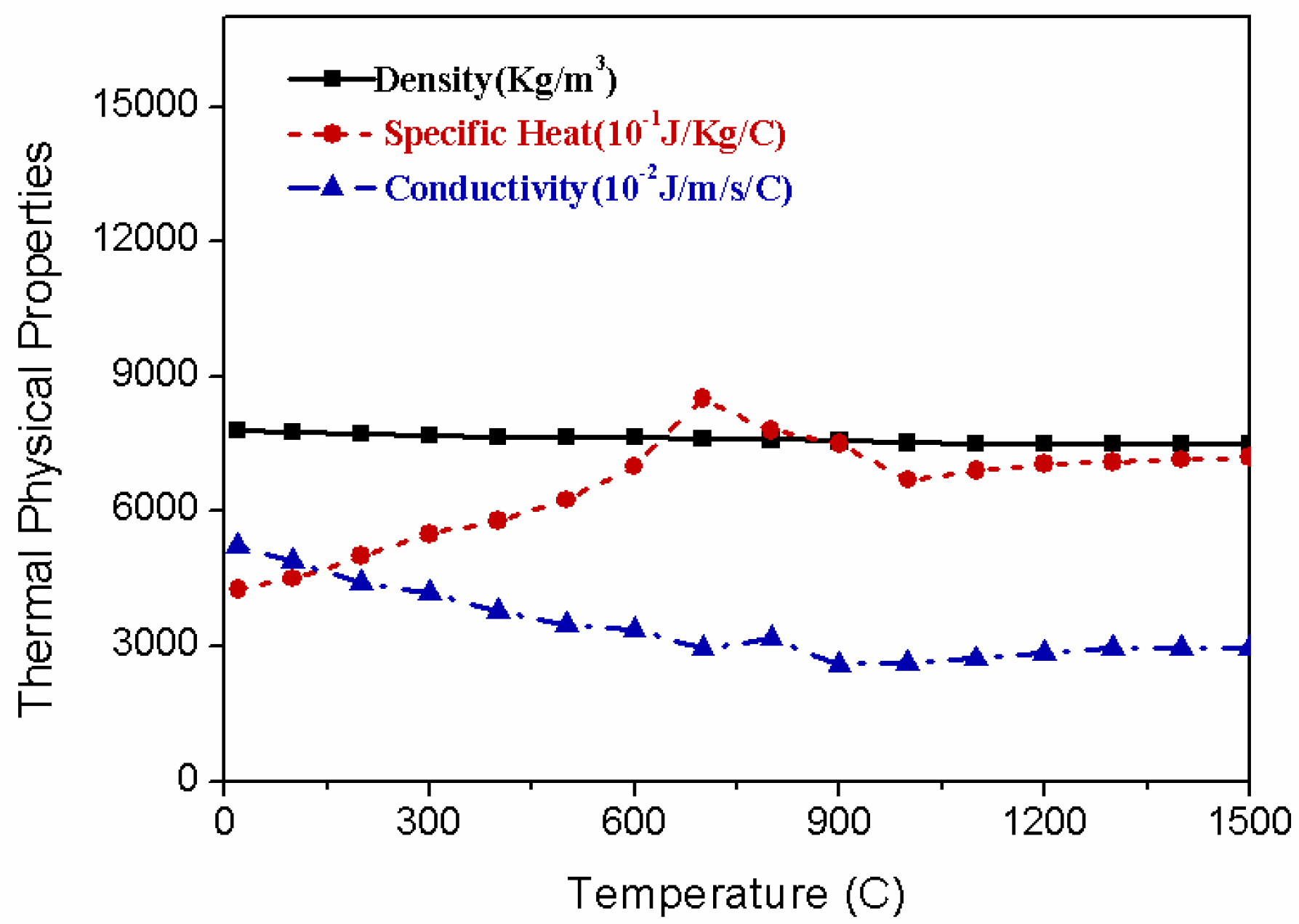
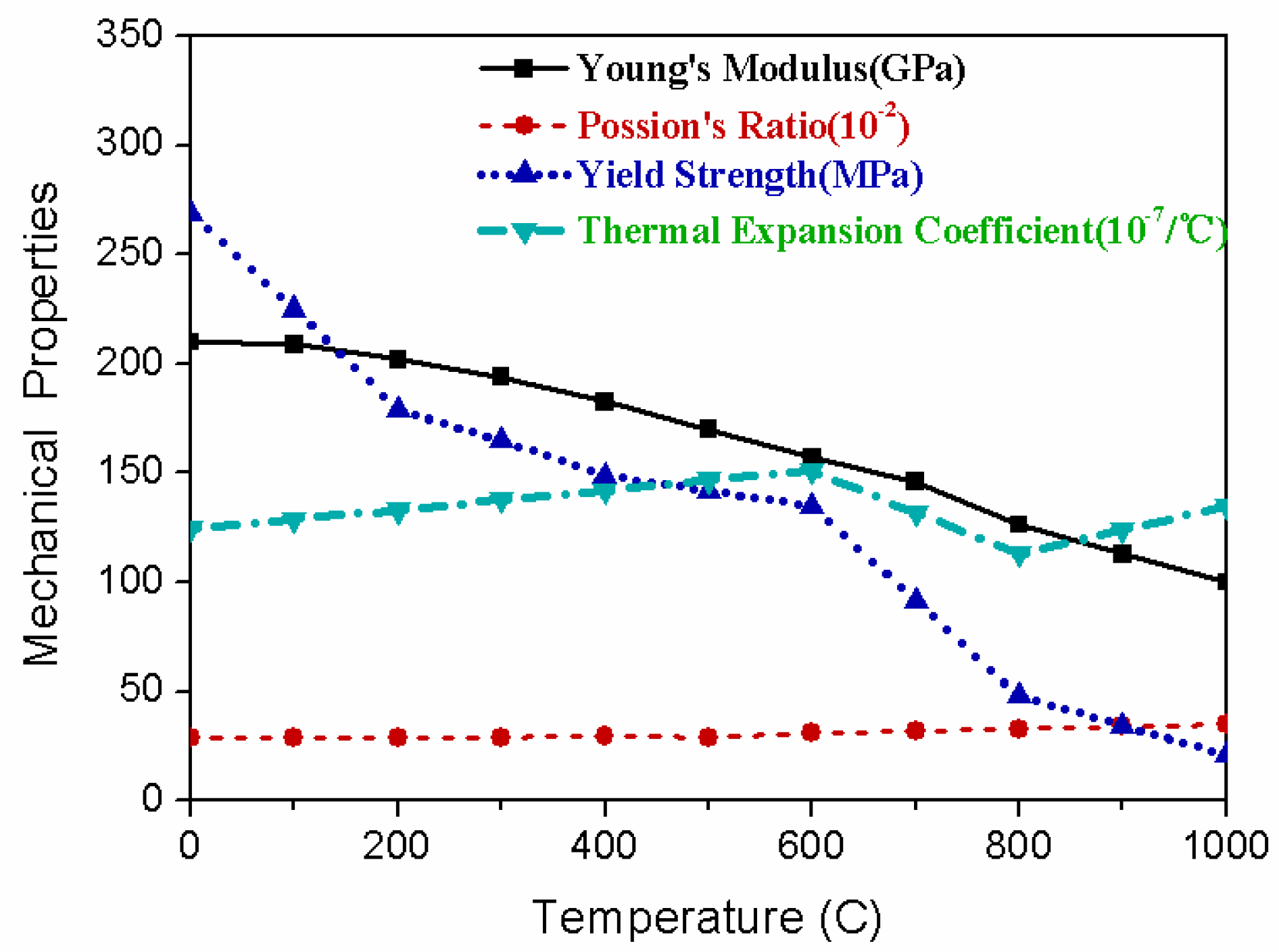

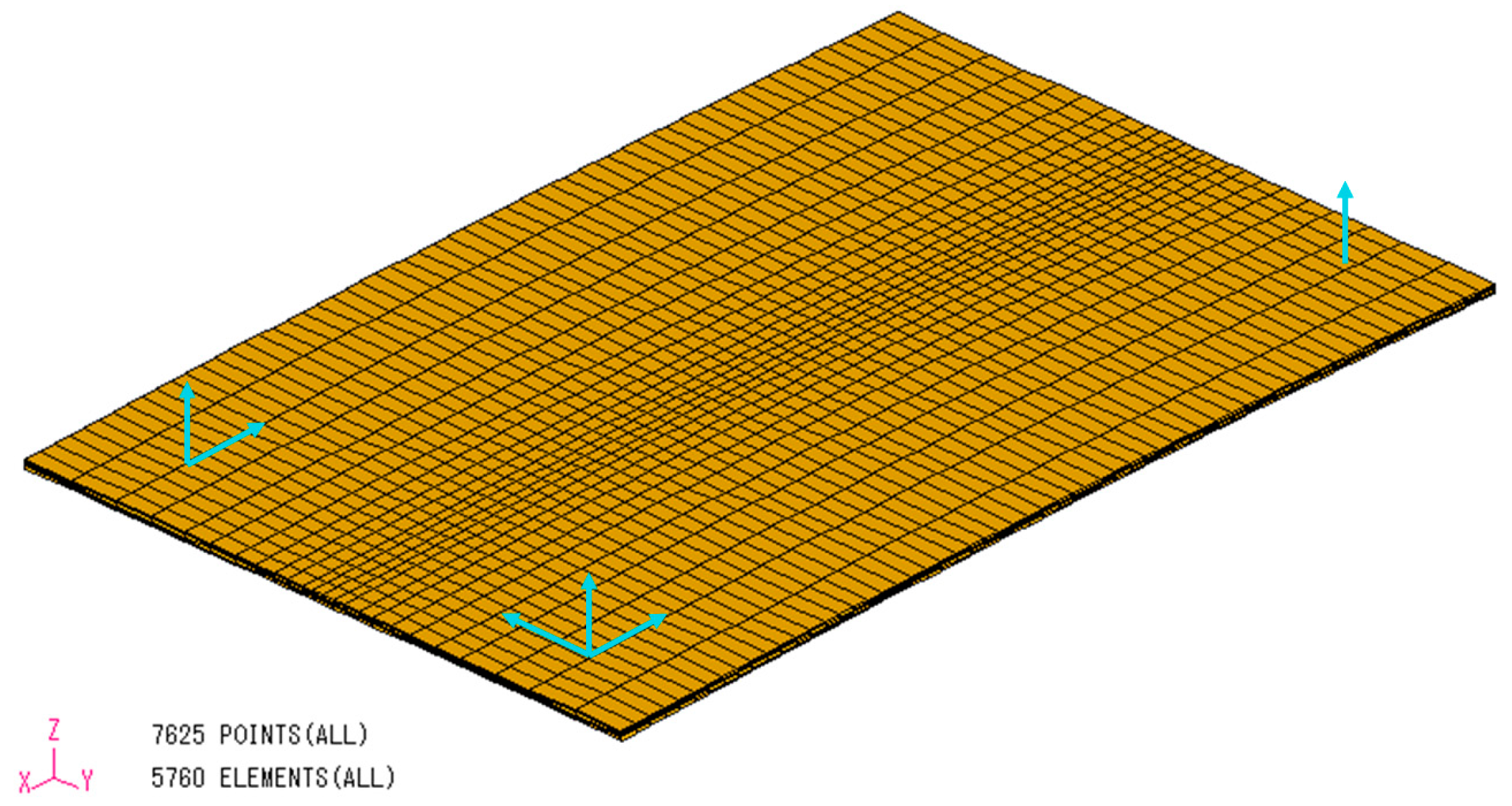
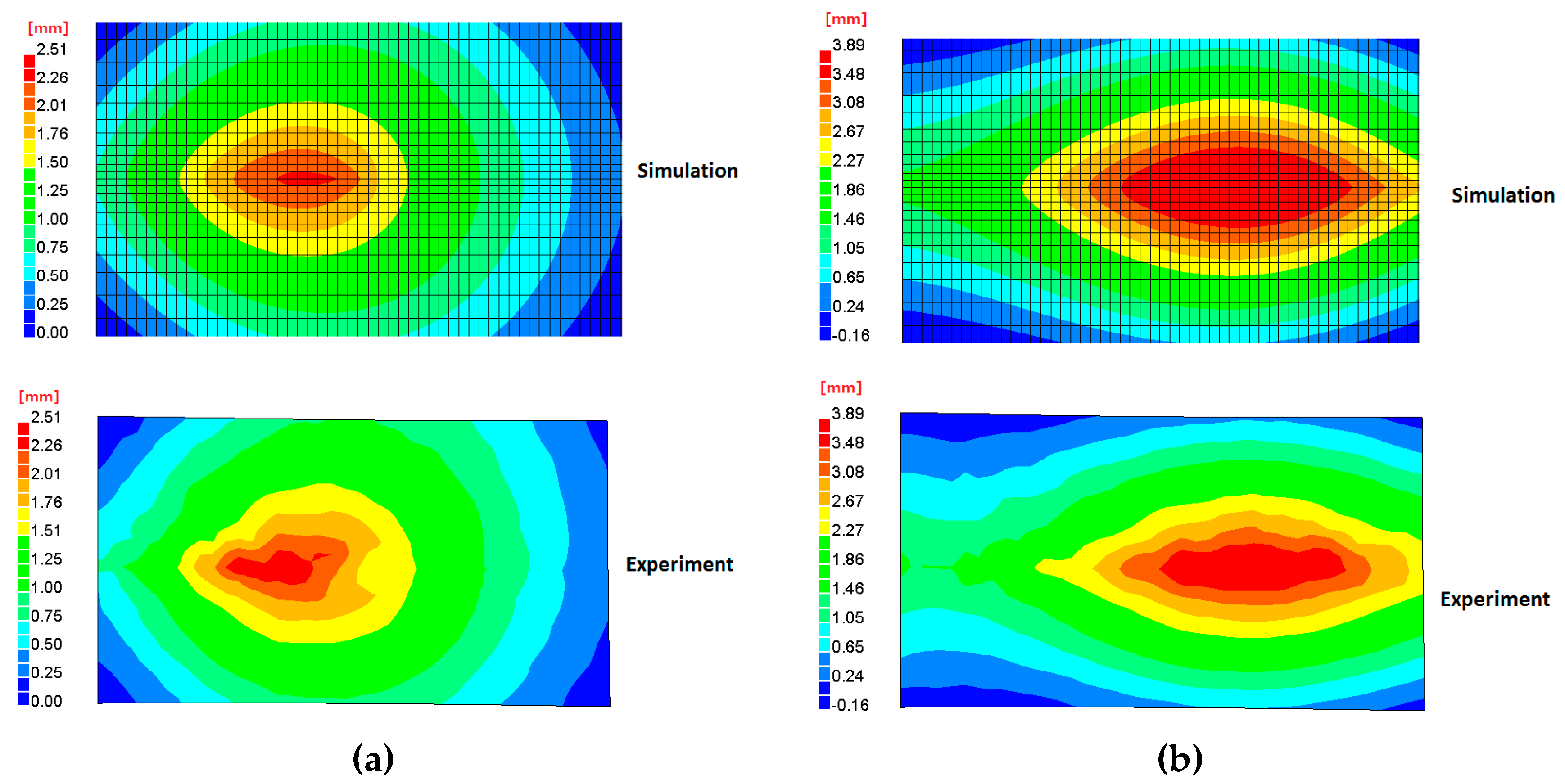
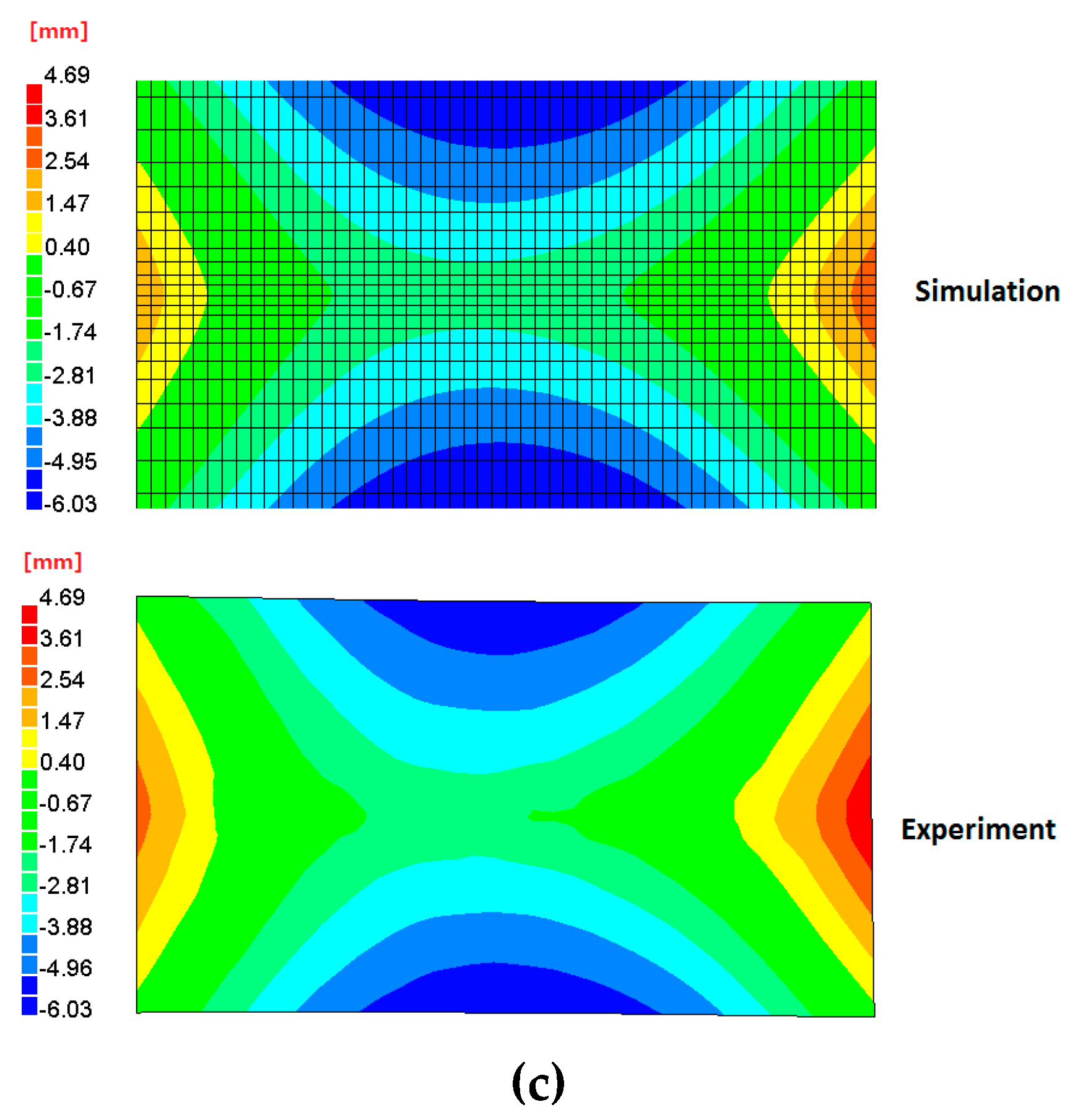

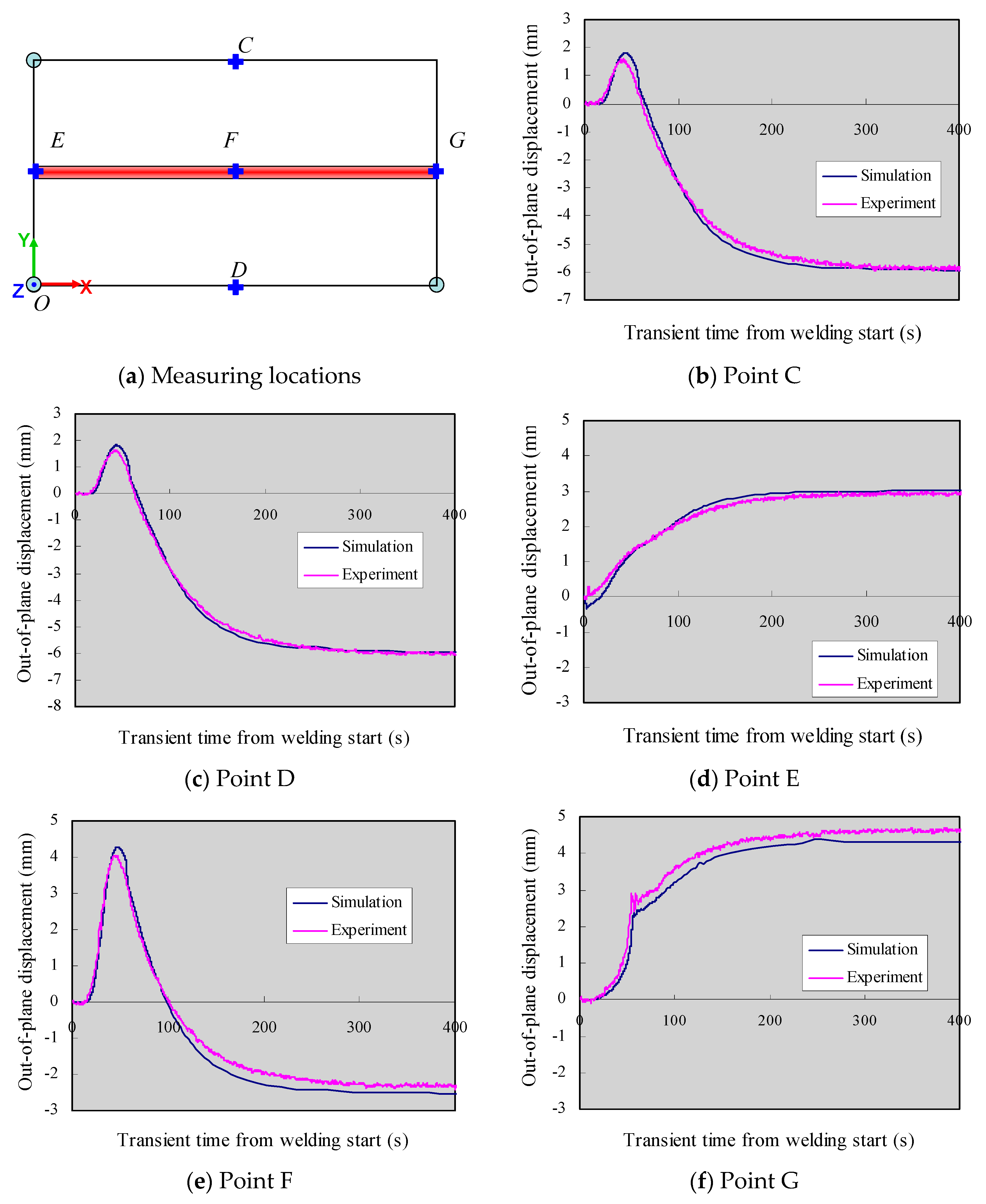

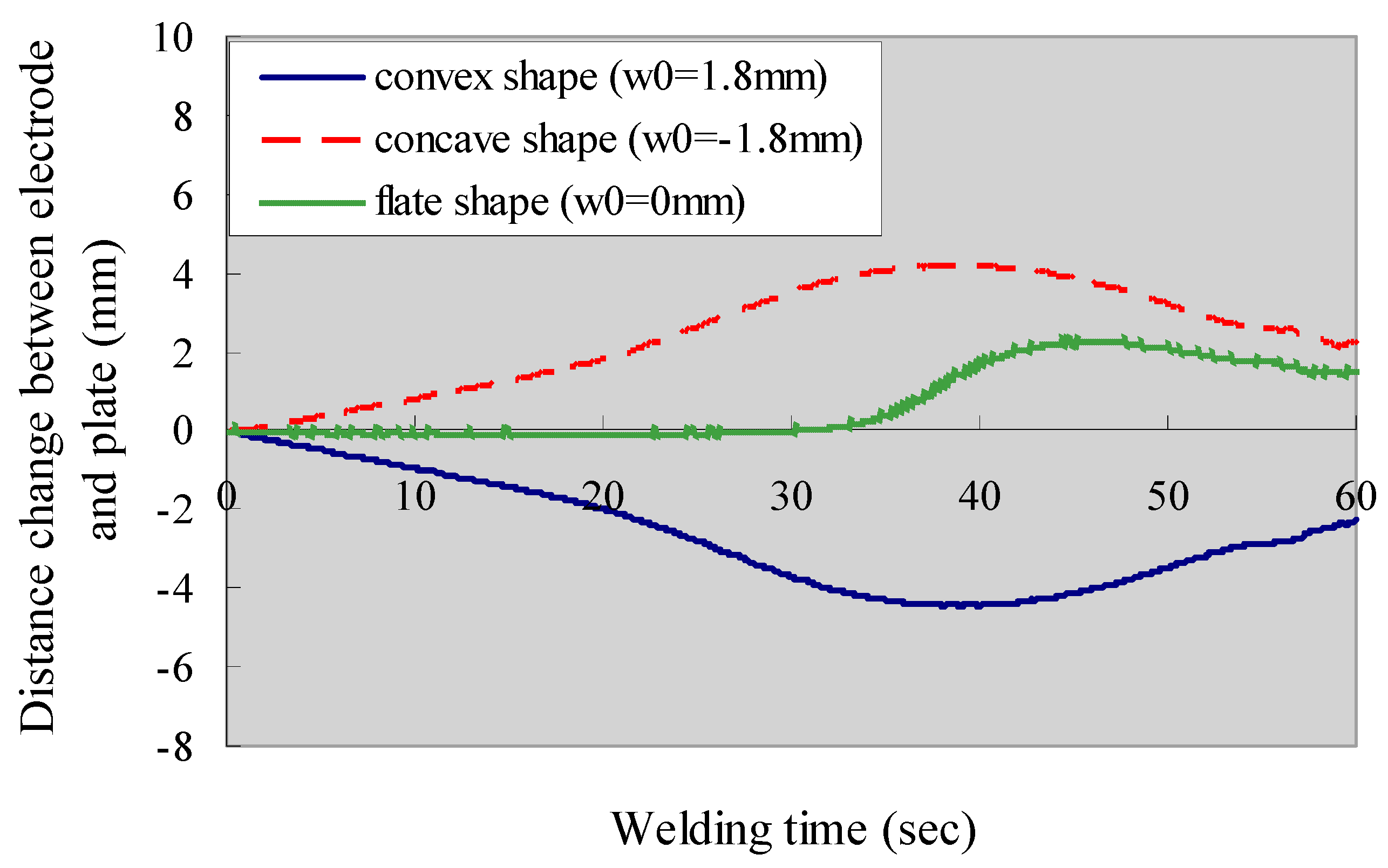
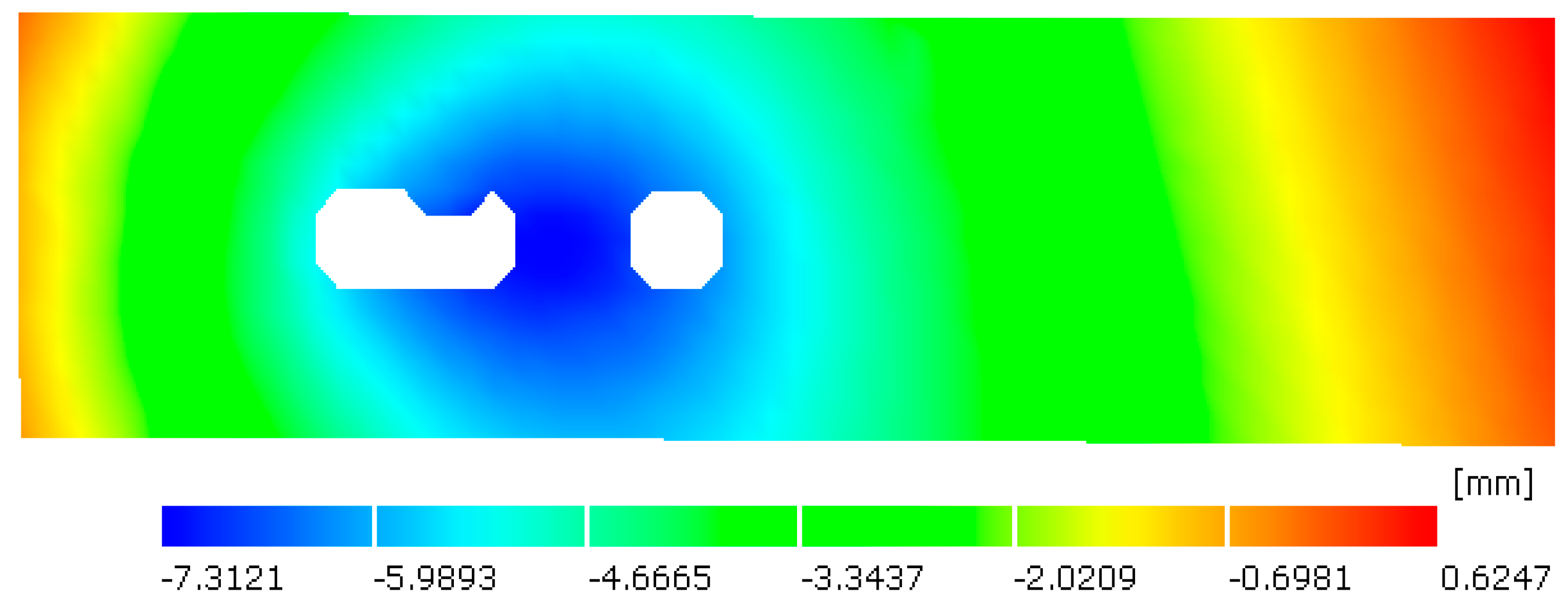

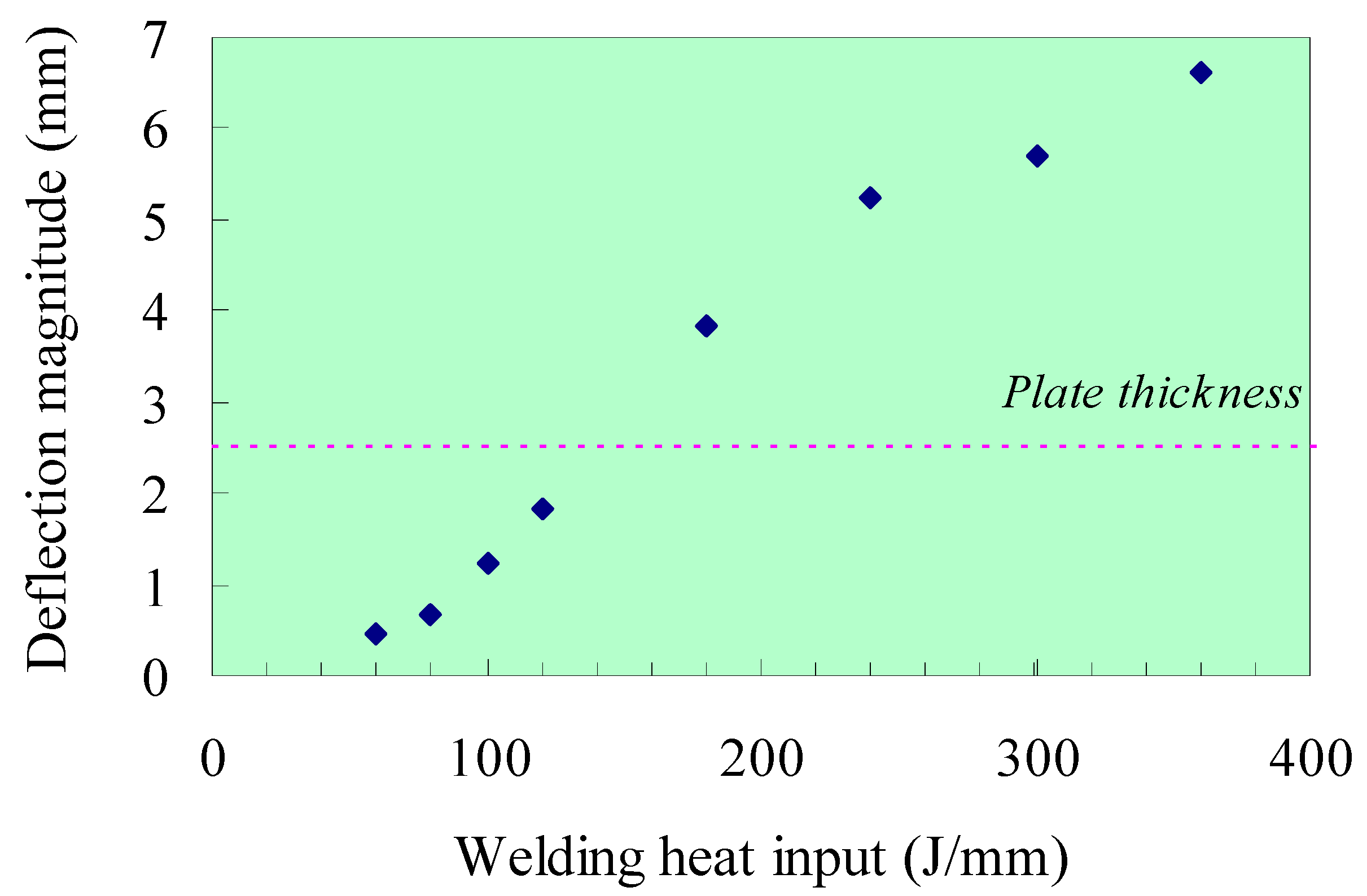
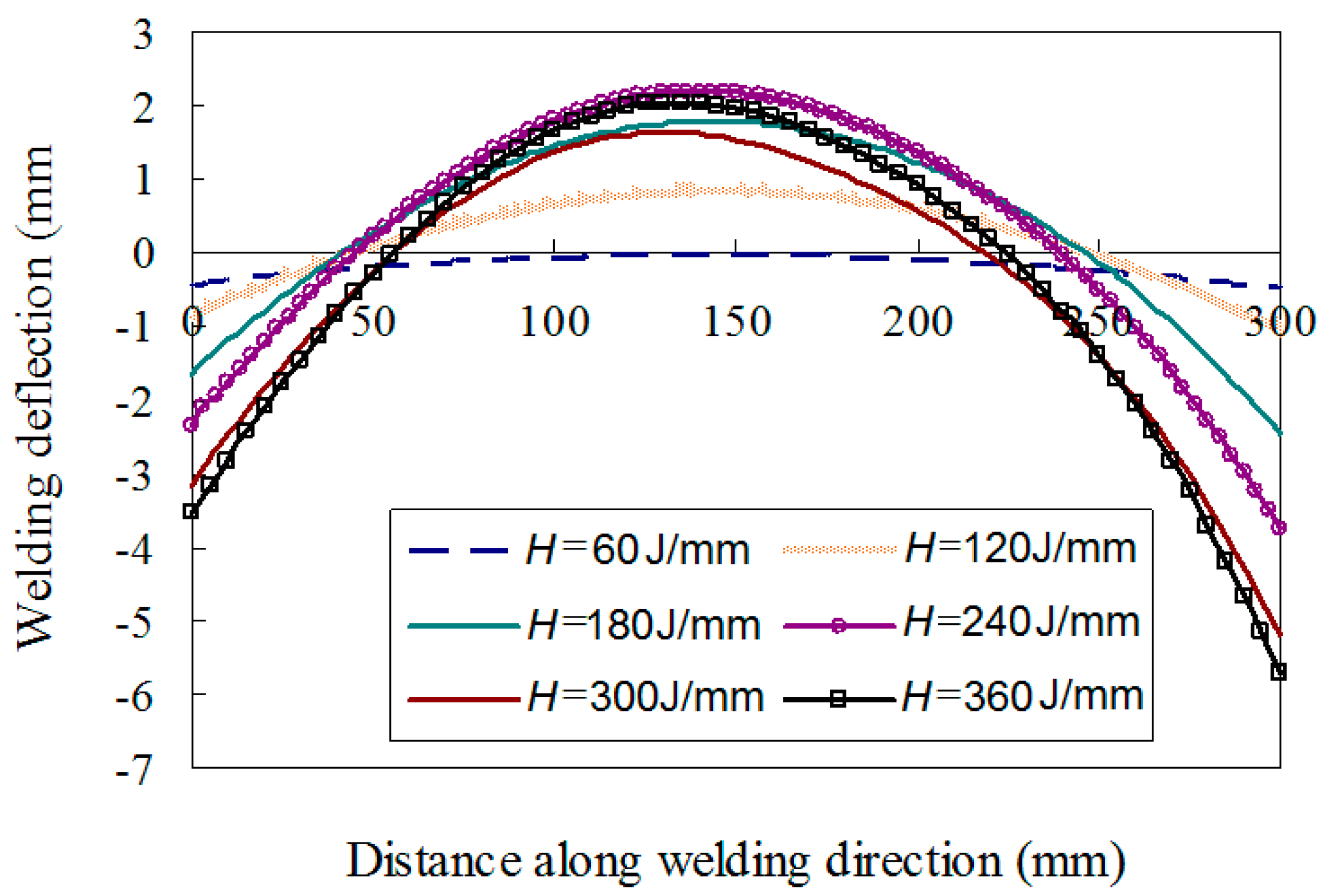
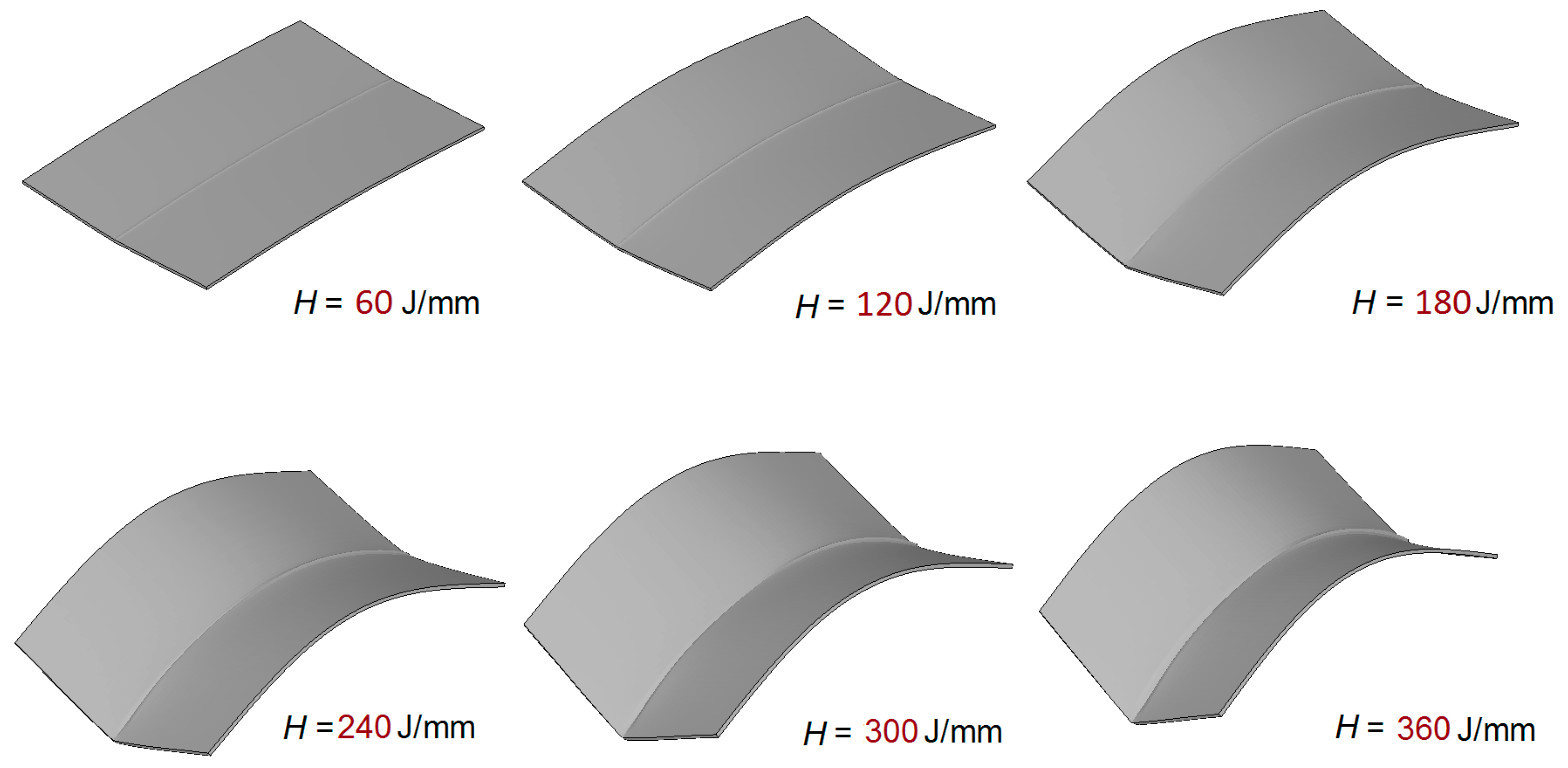
| Welding | Current (I) | Voltage (U) | Welding Speed (v) |
|---|---|---|---|
| TIG | 130 A | 16 V | 30 cm/min |
© 2019 by the authors. Licensee MDPI, Basel, Switzerland. This article is an open access article distributed under the terms and conditions of the Creative Commons Attribution (CC BY) license (http://creativecommons.org/licenses/by/4.0/).
Share and Cite
Huang, H.; Yin, X.; Feng, Z.; Ma, N. Finite Element Analysis and In-Situ Measurement of Out-of-Plane Distortion in Thin Plate TIG Welding. Materials 2019, 12, 141. https://doi.org/10.3390/ma12010141
Huang H, Yin X, Feng Z, Ma N. Finite Element Analysis and In-Situ Measurement of Out-of-Plane Distortion in Thin Plate TIG Welding. Materials. 2019; 12(1):141. https://doi.org/10.3390/ma12010141
Chicago/Turabian StyleHuang, Hui, Xianqing Yin, Zhili Feng, and Ninshu Ma. 2019. "Finite Element Analysis and In-Situ Measurement of Out-of-Plane Distortion in Thin Plate TIG Welding" Materials 12, no. 1: 141. https://doi.org/10.3390/ma12010141
APA StyleHuang, H., Yin, X., Feng, Z., & Ma, N. (2019). Finite Element Analysis and In-Situ Measurement of Out-of-Plane Distortion in Thin Plate TIG Welding. Materials, 12(1), 141. https://doi.org/10.3390/ma12010141






